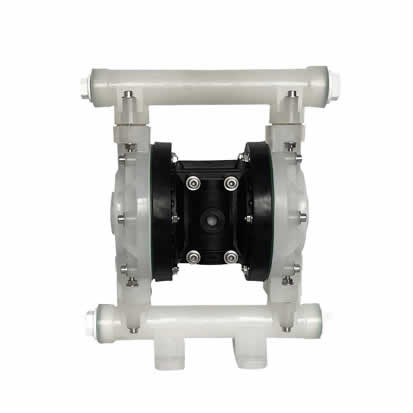Pneumatic diaphragm pump model specifications, pneumatic diaphragm pump product unit price
Many users in the pneumatic diaphragm pump selection will have a lot of confusion, how to choose a suitable diaphragm pump, to consider a number of factors, including material, flow, particle size, temperature, viscosity and so on. At present, the main materials of pneumatic diaphragm pump on the market are cast iron, cast steel, stainless steel, aluminum alloy, engineering plastics, fluorine plastics, etc., enterprises can choose the corresponding material of pneumatic diaphragm pump according to their own liquid delivery; At the same time, it is necessary to refer to the size of the liquid flow and the temperature to choose the size of the diaphragm pump and the type of wearing parts: such as diaphragm pump, valve ball, seat, etc.
Installation and use of pneumatic diaphragm pump main matters
First, the diaphragm pump installation before the matter to understand:
1. Caliber configuration of suction pipe and discharge pipe:
(1) The diameter of the suction pipe shall not be less than the inlet diameter of the pump, such as conveying high viscosity fluid, the diameter of the suction pipe is greater than the inlet diameter of the pump. The suction piping at the inlet must be durable and uncrumpled to produce a high vacuum.
(2) The pipe diameter of the outlet piping should be at least equal to the outlet diameter, or slightly larger to reduce friction loss. All piping and fittings must be sealed and leakproof, otherwise it will reduce the self-priming capacity of the pump.
2, diaphragm pump installation position, height, pipeline layout, gas supply and other matters:
Pneumatic diaphragm pump installation: if the installation details are ignored, long-term careful planning, research and selection will still may lead to poor pumping effect and affect the service life of the pump.
(1) Location: Noise, safety and other logical factors usually have requirements for the location where the equipment should be installed. Parallel installation with conflicting requirements may lead to obstruction in the service area, affecting the installation of other pumps.
(2) Use: First of all, the position of the pump must be easy to use, so that it will facilitate maintenance personnel for daily inspection and debugging.
(3) Air supply: Each pump shall have a snorkel, and the snorkel shall be able to provide enough air to achieve the ideal pumping flow. Air pressure depends on different pumping requirements, but does not exceed 7BAR. (125PSI)
(4) Installation height: please fully consider the self-priming capacity of the pump to avoid the problem of self-priming reduction.
(5) Piping: The final decision on pump location can not be made until each possible piping problem location has been considered.
Pneumatic diaphragm pump is a new type of conveying machinery, using compressed air as power source, for all kinds of corrosive liquid, liquid with particles, high viscosity, food hygiene grade liquid, volatile, flammable, highly toxic liquid, can be pumped out. It is a transportation equipment widely used in petrochemical industry, medical electronics, environmental protection, food brewing, electric power energy, municipal drainage and so on.
